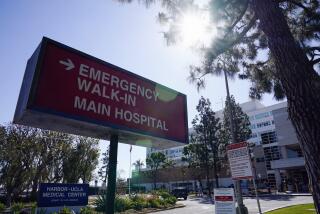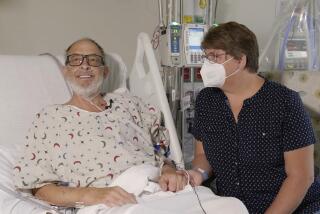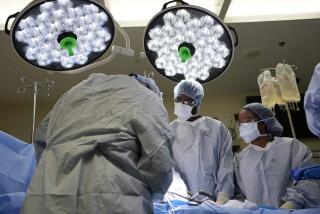UCLA Party for Heart Transplant Recipients : Toasting a Holiday That Might Never Have Been
- Share via
As holiday parties go, this one was a tad staid: two musicians playing classical rather than Christmas music, polite conversation rather than exuberant overindulgence, and not even a tree.
Nevertheless, the honored guests at the party hosted last week by UCLA’s heart transplant program were enjoying themselves--and the irony of the situation. For as a buoyant Nick Micale observed, no one would be honoring them if at some point they hadn’t been given six months to live.
That grim pronouncement had qualified them for a heart transplant--which they’d had. And now here they were: sipping wine, nibbling hors d’oeuvres and mingling in fine holiday form.
Except for three Visalia residents: Gordon Gadow, 41, Dolores Pineda, 48, and Mark Shandra, 29. Gadow was going to fly them down in his private plane but they were fogged in.
Which just goes to show, quipped Dr. Hillel Laks, chief of cardio-thoracic surgery at the UCLA School of Medicine, “that superhuman as these heart transplant patients appear to be, their powers apparently do not extend to controlling the weather.”
You could spot the heart transplant recipients by the red carnations on their lapels. Otherwise--no wheelchairs, no pallor nor emaciated stoop--the five recipients who made it to the party from 6 to 8 p.m. in the UCLA Faculty Lounge looked no different from the doctors, nurses and other support staff.
And that’s one of the reasons why they decided to have the party, clinical nurse specialist Suzanne Clark said, “because even the patients don’t realize how well they’re going to recover. This way they can see each other.”
Of the 12 people who have received new hearts since UCLA Medical Center’s heart transplant program began in February, 1984, 10 survive. The five at the party were: Lawrence Beard, 19, of Los Angeles; George Happe, 35, of Torrance; John Pluth, 48, of Glendale; Thomas Tahmassebian, 38, of Glendale; and Micale, 54, of Santa Monica.
Besides the three from Visalia, there’s Anissa King, 14, of Los Angeles, who couldn’t come due to an illness in her family, and Sylvester Stovall, 45, of Arleta who had his transplant on Dec. 11 and was still hospitalized.
If the atmosphere seemed subdued for a holiday party, it was nevertheless a sentimental evening. Particularly for the medical staff who, as Laks said, sometimes overlook the human side for all the medical statistics and procedures. “Seeing these people now with their families, well, I don’t think I realized the impact of making someone healthy.”
The transplant recipients knew, however. And they were happy to talk about it. In those weeks and months before the surgery, they’d be out of breath just crossing the street.
“Now I can work around the house,” said Micale, who had surgery June 17. “There’s no excuse for me to be lazy now.” Beard, who received his new heart Sept. 7, began riding his bike this month. Gadow, whose surgery was on April 10, 1984, was even skiing, reported Dr. Lynne Warner Stevenson who, as assistant adjunct professor of medicine-cardiology, manages the follow-up care of transplant recipients.
As the patients saw it, the important thing now was deciding what they wanted to do with their renewed lives. All of them had been unable to work in the months before their surgery and after, well, there were just so many possibilities.
Pluth wryly observing that the date of his surgery, Sept. 19, “was etched in my mind,” didn’t know when he’d be able to return to his job in retail management. “But I think now I’d like to get into something really big time.”
Tahmassebian, a truck driver who received his new heart on Aug. 2, 1984 (and, he was teased, forced Laks to cut short his vacation in Hawaii), wants to open an ice cream shop in Lake Castaic. Micale said he’d like to open an Italian deli for his wife and children to operate. Beard is returning to college to study computer programming.
They laughed as they talked: Yes, they’d had to cut down on their liquor consumption. Essentially just one glass of beer or wine or hard liquor a day. “And I was a big gin drinker,” Micale said with a sigh. Also, there was a lot of medication to be taken and they couldn’t exactly indulge in Christmas binges, though they could eat most anything in moderation. And there always was somebody checking up on them, particularly their wives. “I’m on a long leash,” Kluth said.
Wives’ Reactions
Watching their husbands, enjoying their optimism, were the wives. They were quieter. Their husbands may have experienced the surgery, but with that there was almost immediate progress: two to four weeks in the hospital, then out and onward toward recuperation.
The wives, however, had experienced a loneliness and helplessness not so easily healed. Diane Micale, who had kept a diary during the transplant period, kept her manner light as she talked about “the euphoria of the transplant” and all the people who’d want to visit her husband, while forgetting her. “I felt like an outsider,” she said, only half joking.
“You worry about him as if he were a baby, and that’s no good,” said Diane Happe, whose husband has been in and out of the hospital 15 times with other complications since his transplant on March 27. She looked at her children, Allison, 8, and Eric, 12, and fought back a little mistiness. “Without the transplant, George wouldn’t have lived until June. So . . . But what’s hard is that my son has the same disease, restrictive cardiomyopathy. . . . Though the doctors say lots of people go for years with it.”
The party went on. Diane Micale took pictures of her husband with all the people who attended him, then pictures of the other recipients and their families. Nick Micale joked about how last New Year’s, his wife had said no more hospital stays “and then on March 3, I’m in the hospital with my heart, really bad this time; in June, the heart transplant; in September, my spleen is removed and in November, I get pneumonia. If she opens her mouth this year, I’m going to have to do something.”
The doctors talked about the increasing number of heart transplants, more than 500 since the first one in 1967 by Dr. Christiaan Barnard, and how the survival rate was improving: about 80% make it through the first year, while 50% make it five years.
But nobody talked about the other side of those statistics. It just wasn’t important. What was important, several of the wives said, was “just to have a wonderful Christmas, to enjoy every day.” Or, as Diane Happe said, pulling her children close as she watched her husband across the room, “I’ll tell you how we live: We live one day at a time.”
More to Read
The biggest entertainment stories
Get our big stories about Hollywood, film, television, music, arts, culture and more right in your inbox as soon as they publish.
You may occasionally receive promotional content from the Los Angeles Times.










